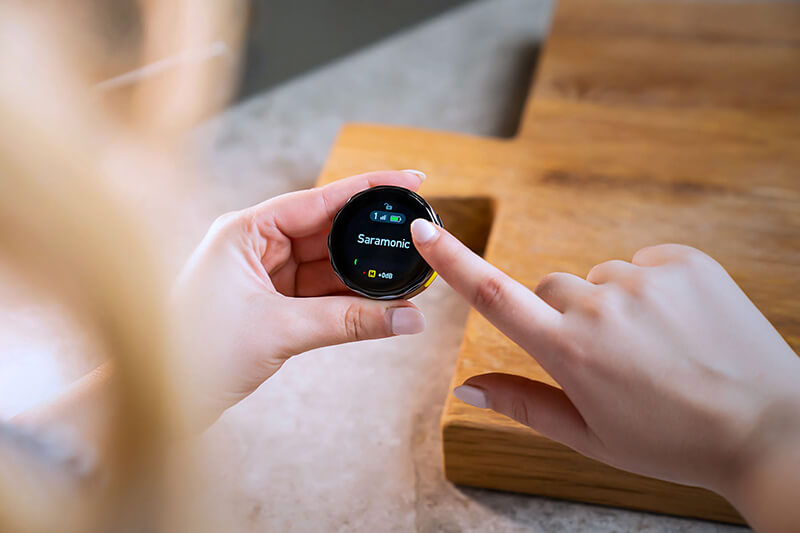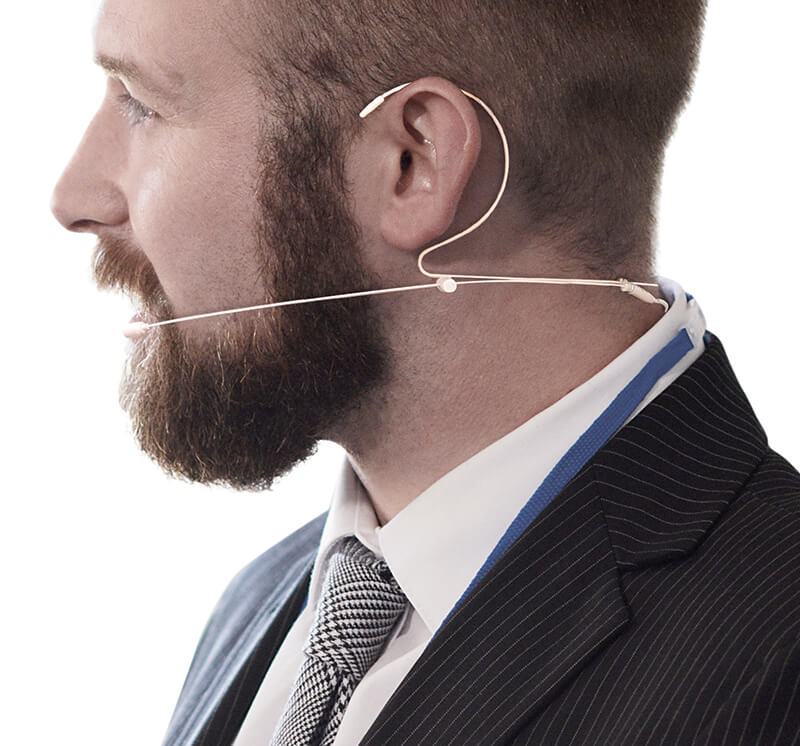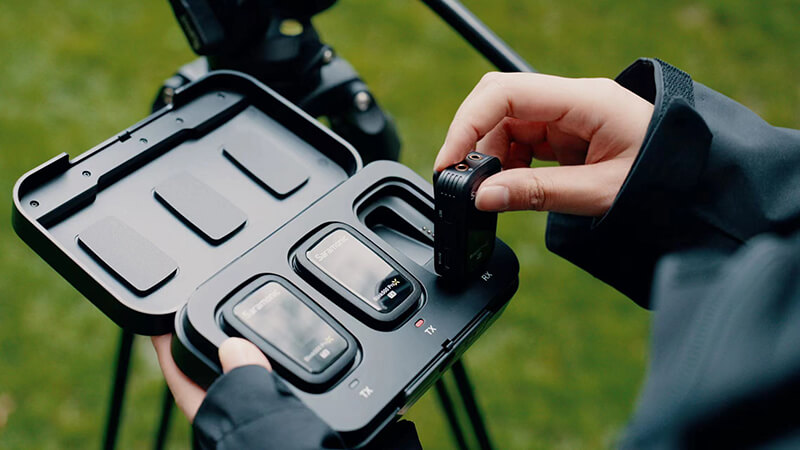What type of wireless microphone is best?When it comes to capturing pristine audio, especially in scenarios that demand mobility and flexibility, wireless microphones are an absolute game-changer. Whether you're a content creator, a presenter, a performer, or someone looking to enhance their audio recording capabilities, finding the best wireless microphone for your needs is paramount. In this guide, we'll delve into the world of wireless microphones, exploring the different types and their key features to help you make an informed decision.
-
Types of Wireless Microphones Wireless Lavalier Microphones : These are small clip-on microphones that are often used in situations where the microphone needs to be discreet. They are commonly used by presenters, public speakers, and broadcasters. Wireless Lavalier microphones offer hands-free operation and can be easily attached to clothing.
 ↑ Saramonic BlinkMe Wireless Lavalier Microphone
↑ Saramonic BlinkMe Wireless Lavalier Microphone
Handheld Microphones: These are the classic microphones you often see singers using on stage. They provide a comfortable grip and are versatile for various performances, from live concerts to public speaking engagements. Handheld wireless microphones usually include a built-in transmitter.
Headset Microphones: Ideal for performers who require both hands free, headset microphones combine a microphone and headphones in one unit. These are commonly used in theater productions, fitness instruction, and live broadcasting.
↑ Saramonic DK6 Headset Microphone
Shotgun Microphones: Although less common in wireless form, shotgun microphones are excellent for recording audio from a distance, making them suitable for video production and outdoor events.
Key parameters of wireless microphone
Microphone Sensitivity
Microphone sensitivity pertains to its capacity to detect sound, illustrating its responsiveness and range during sound pickup. Typically gauged in decibels (dB), higher sensitivity empowers the microphone to capture even the most subtle nuances of sound. Conversely, lower sensitivity suggests reduced receptiveness to sound.
Hence, the question arises: is higher sensitivity superior, or is lower better? Amplified microphone sensitivity captures intricate sound intricacies, contributing to lucid and enriched audio output. Nevertheless, this elevation in sensitivity could also entail heightened background noise pickup. Ergo, the sensitivity choice hinges upon the specific recording requisites. For instance, for indoor applications such as live streaming, a high-sensitivity model is ideal. Conversely, if outdoor recording takes precedence, then a model furnished with a one-touch noise reduction function and a wind-resistant cover to curtail environmental noise is recommended.
Frequency Response Range
Frequency response range conveys the scope of sound frequencies the microphone can intercept and convey, commonly denoted in Hertz (Hz). The human auditory range typically spans from 20 Hz to 20,000 Hz. A broader frequency response range culminates in enhanced performance across low and high frequencies, thus favoring higher values.
↑ saramonic Blink900S wireless lavalier microphone
Wireless Operating Distance
For individuals directing their attention towards outdoor recording, opting for a model encompassing a transmission range of 100 meters or more proves optimal, facilitating a more extensive array of recording situations.
Sampling Rate
The sampling rate denotes the instances wherein the analog audio signal is sampled within a second. Elevated sampling rates facilitate the recreation of high-fidelity audio. As an example, contemporary mainstream models commonly embrace a sampling rate of 48kHz, emblematic of 48,000 samples per second. In comparison, the sampling rate of CD discs usually manifests as 44.1kHz. Opting for a model underpinned by a 48kHz sampling rate is paramount for ensuring audio quality.
Battery Life (Endurance)
Prominent models prevalent in the market frequently extend battery life to 5 hours or more. Opting for models with relatively shorter battery longevity necessitates prudent deliberation, particularly for vloggers engaged in prolonged outdoor recording sessions. Models accompanied by charging cases are even more advantageous, negating the need to tote power banks or embark on quests for charging stations.
↑ Blink500 ProX wireless lavalier microphone
Signal-to-Noise Ratio (SNR)
The signal-to-noise ratio encapsulates the ratio between the valuable signal captured by the microphone and the ambient background noise. It serves as a pivotal gauge of microphone performance, assessing the clarity of sound and the microphone's efficacy in suppressing noise. A superior SNR underscores a heightened prominence of the valuable signal relative to background noise, thereby empowering the microphone to precisley apprehend sound and offer superior audio quality.
Maximum Sound Pressure Level
The maximum sound pressure level conveys the zenith of sound intensity the microphone can endure sans distortion or impairment, commonly quantified in decibels (dB). It signifies the pinnacle of sound intensity the microphone can manage. Analogous to previous factors, larger values are favorable for this parameter.
Best Wireless Microphones of 2023
Saramonic BlinkMe's transmitter and receiver both feature high-resolution full-color displays, with highly sensitive touchscreen responses that enable users to access various microphone functions through touch, including mode settings, internal recording, and mute functions. The sliding controls for brightness and gain adjustments make operations more convenient and user-friendly, enhancing the overall user experience. The unique custom design feature allows users to personalize themes, wallpapers, and other content for the two transmitters using the app, providing a distinct and personalized experience. In terms of audio quality, BlinkMe inherits Maple Flute's professional audio tuning technology, resulting in exceptional sound dynamics. The optimized 2.4GHz wireless transmission technology ensures stable signal transmission, maintaining excellent recording quality even in complex signal environments.

BlinkMe adopts a self-developed 6mm omnidirectional microphone capsule with a 48kHz sampling rate and a signal-to-noise ratio greater than 80dB, surpassing even CD-level sound quality effects, delivering enduring and outstanding sound quality. Considering diverse recording needs, BlinkMe offers up to 15 hours of 24-bit onboard recording at -6dB safety track, ensuring high-quality audio recording results while preventing audio data loss, distortion, and other issues, ensuring audio data security. The exterior design of BlinkMe has been comprehensively upgraded, encompassing overall form, material selection, and detailed configuration. With features like a circular body, irregular edges, personalized theme design, and high-transparency shock-resistant glass, BlinkMe aligns its appearance with contemporary fashion and individualistic demands. It introduces an industry-first integrated design, where the receiver also functions as a charging case. The transmitter connects to the receiver via charging touch and magnetic attraction, creating a unified unit that improves product portability and mitigates the risk of individual component loss. It also incorporates an automatic power on/off design, making it convenient for users to start recording instantly.

Numerous design details demonstrate BlinkMe's departure from conventional design language, embracing non-traditional design concepts. This grants the microphone heightened aesthetic and practical attributes, offering users improved options and richer functionality, delivering a dual experience of visual and auditory pleasure. Addressing the common concern of battery life, BlinkMe doesn't disappoint. A single transmitter can record for up to 8 hours continuously without internal recording activated. The receiver boasts an extended battery life of up to 24 hours on a full charge, capable of providing a full recharge cycle for a single transmitter, making all-day recording a breeze.
In response to the multi-use needs of small teams, BlinkMe introduces a dual output design, allowing simultaneous digital and analog signal output for dual-device recording, setting it apart from microphones that can only connect to a single port.
As for transmitter wearing options, in addition to the traditional back-clip method, BlinkMe offers versatile magnetic accessories. The transmitter, receiver, various magnetic plates, and back-clips can be easily attached in a variety of combinations, making it effortless to record even with clothes unsuitable for clipping.
BlinkMe combines innovative functionality with cutting-edge design, offering users a comprehensive and exceptional microphone experience that caters to various recording scenarios.
 ↑ Saramonic BlinkMe Wireless Lavalier Microphone
↑ Saramonic BlinkMe Wireless Lavalier Microphone




